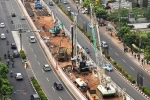Infrastructure successfully reduces poverty
Infrastruktur Sukses Turunkan Kemiskinan
Media Indonesia, 28 April, 2017
By Andhika Prasetyo
Concerns about economic disparities also arise. This is in view that, after the infrastructure is completed, its management falls on those at the top level.
Coordinating Minister for Economic Affairs, Darmin Nasution, has revealed that the quality of economic growth in Indonesia in 2016 is quite good. It is characterized by economic growth that goes in line with declines in unemployment and poverty.
Central Bureau of Statistics (BPS) notes that, as of September 2016, the number of poor people in Indonesia reached 27.76 million people, or 10.70 percent of the total population. This figure is smaller than the condition of March in the same year, which records 28.01 million people, or 10.86 percent.
"Statistically, this has happened because 40 percent of the people in the lowest income bracket registered a faster increase in consumption compared to the upper groups," explained Darmin.
The increase in the people’s consumption at the lower and middle levels cannot be separated from government policy in building infrastructure on a large scale throughout Indonesia.
"Starting from roads, ports, airports, trains, everything. All that construction, who do the works at the beginning? Definitely labourers. That is what makes [consumption] go up."
Nevertheless, at the same time, concerns about economic inequality also emerge behind all this. The reason is that, after all the infrastructure projects are completed, the management will surely fall on the people at the top level.
"That is the question. When the infrastructure [projects] have finished, who will get the profit? Who will get bigger increases in income? Those at the bottom or those at the top? The prediction clearly points to the top. This is where our task is, to continue lowering the Gini ratio," said Darmin.
He said that the government continues to work on the schemes of development that have been implemented in the last two years, such as infrastructure, deregulation, de-bureaucratization, as well as encouraging the development of industry and tourism and other sectors.
Investment constraints
On the other hand, business actors have complained about the many levies that impede investment. Another obstacle is the lack of infrastructure that will support the investment and the lack of support from regional governments.
Chairman of the Indonesian Chamber of Commerce and Industry (Kadin Indonesia), Rosan Roeslani, confirms the absence of full support from local governments, for example, there are still levies to investors before the business runs. "One of the issues is the presence of several charges from the local government before the business or investment is executed," Rosan said.
He said that, although these charges are official and they are contained in local regulations, they amount to an obstacle to investment.
"Indeed, they count as official charges, but, for business actors, they are quite impeding," explained Rosan. (Arv/Adi/E-4)











